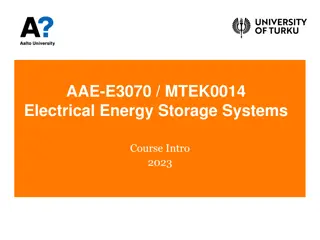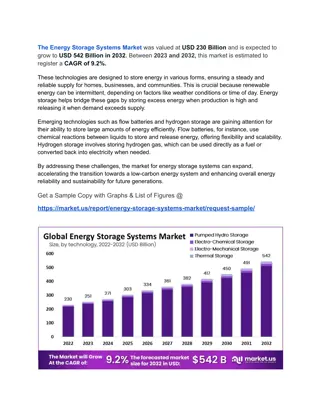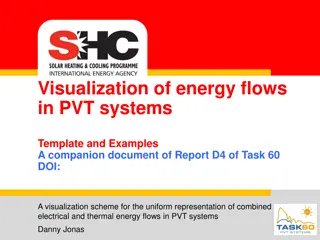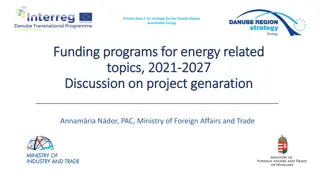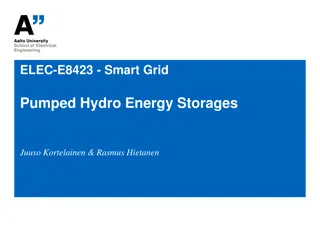Review of Energy Storage Systems for Sustainable Decision-Making
This study by Dominik Huber investigates the adequacy of energy storage system reviews in providing information to identify sustainable technology. The research delves into renewable energy carriers, energy storage technologies, literature research questions, and methodologies applied such as frequency analysis and sustainability literature review. The study aims to identify the most economical publications on relevant parameters and assess the societal and environmental impacts of different energy storage technologies.
Download Presentation

Please find below an Image/Link to download the presentation.
The content on the website is provided AS IS for your information and personal use only. It may not be sold, licensed, or shared on other websites without obtaining consent from the author. Download presentation by click this link. If you encounter any issues during the download, it is possible that the publisher has removed the file from their server.
E N D
Presentation Transcript
Source: https://pixabay.com/photos/apples-basket-basket-of-apples-5567884/ DOMINIK HUBER | 17-7-2024 | 1/21
A REVIEW ON REVIEWS OF ENERGY STORAGE SYSTEMS: DO WE KNOW ENOUGH TO MAKE A SUSTAINABLE DECISION? DOMINIK HUBER 1st IAEE online conference This study has been funded by the Agency for Innovation and Entrepreneurship (VLAIO) in the ICON project MAMUET grant HBC.2018.0529.
OUTLOOK 1. Introduction 2. Methods 3. Results 4. Discussion 5. Conclusion 6. Bibliography DOMINIK HUBER | 17-7-2024 | 3/21
INTRODUCTION Renewable energy carriers (REC) Energy storage technologies (EST) LITERATURE RESEARCH QUESTION EST: variability and reliability issues of REC EST: key role for REC integration solution for Great variety of EST Different impacts commission (structure) Selection of only based technological characteristics Great variety of studies focused environmental of different EST Assessment of different impacts Do EST reviews provide sufficient information to identify the sustainable technology? environmental on before impacts most EST: not on DOMINIK HUBER | 17-7-2024 | 4/21
METHODS APPLIED METHODS FREQUENCY ANALYSIS SUSTAINABILITY LITERATURE REVIEW 3 pillars of sustainability Commercial & scientific Aim: identification of most Economy publications on multiple relevant parameters Environment storage technologies Frequency of parameters Society Search string: energy storage Inclusion: parameter reported SDG 7: affordable & clean technologies overview 3 times or more energy Selection criteria: Reporting in structured form Various storage technologies DOMINIK HUBER | 17-7-2024 | 5/21
METHODS APPROACH & OPERATIONALIZATION (1) 3RDSTEP 1STSTEP FREQUENCY ANALYSIS LITERATURE REVIEW Technology classification: Explorative literature study Mechanical, Chemical, Scopus & Google Scholar search Electro-chemical & Thermal Search string: energy storage energy storage technologies technologies overview 4THSTEP 2NDSTEP FREQUENCY ANALYSIS LITERATURE REVIEW Unit adjustment Selection criteria: Homogenization of different Reporting in structured form units per parameter Reporting on various technologies DOMINIK HUBER | 17-7-2024 | 6/21
METHODS APPROACH & OPERATIONALIZATION (2) 6THSTEP EVALUATION Data base generation: Quantitative and qualitative values Minimum, maximum and average values 7THSTEP 5THSTEP EVALUATION FREQUENCY ANALYSIS 3 pillars of sustainability Parameter analysis: Do studies report comparable economic, Included parameters: 3 < studies environmental or social information? reported on same parameter DOMINIK HUBER | 17-7-2024 | 7/21
RESULTS OVERVIEW OF STUDIES & CLASSIFICATION OF STUDIES Sources Publication in scientific journal Reports of research institutes/universities Report from industry (Akinyele & Rayudu, 2014) (Aneke & Wang, 2016) (Cho & Gabbar, 2019) (Connolly, 2010) (Deloitte, 2015) (JU, 2015) (Fuchs et al., 2012) (Gallo et al., 2016) (Khan et al., 2019) (Kousksou et al., 2014) (Lazard, 2018) (Mahlia et al., 2014) (Mongird et al., 2019) (Sabihuddin et al., 2015) Total 1 1 1 1 1 1 1 1 1 1 1 1 1 1 8 4 2 DOMINIK HUBER | 17-7-2024 | 8/21
RESULTS CLASSIFICATION OF TECHNOLOGIES MECHANICAL EST CHEMICAL EST ELECTRO-CHEMICAL EST THERMAL EST Pumped hydro EST (2) Conventional batteries (12) Superconducting magnetic Pumped thermal EST (1) EST (2) Compressed air EST (7) High-temperature batteries Hot/cold thermal EST (2) (3) Supercapacitors (1) Liquid air EST (3) Sensible/latent/reaction heat Flow batteries (3) Other capacitors (1) EST (3) Flywheel EST (3) Metal-air batteries (3) Cryogenic EST (1) Gravity EST (2) Fuel cell batteries (5) Molten salt EST(1) Others (5) Underground(aquifer) EST (1) Summary Total number of included technologies: 61 Mechanical energy storage technologies (EST): 17 Chemical EST: 31 Electro-chemical EST: 4 Thermal EST: 9 DOMINIK HUBER | 17-7-2024 | 9/21
RESULTS OVERVIEW OF INCLUDED PARAMETERS Technological parameters Parameter Lifetime Lifetime Energy density Efficiency Power rating Response time Power density Round trip efficiency Daily self-discharge Storage time Discharge time Economic parameters Parameter Energy cost Power cost CAPEX Fixed OPEX Variable OPEX Other parameters Parameter Technology maturity Environmental impacts Unit Years Cycles Wh/l % MW Minutes W/l % % Hours Hours n 12 9 9 8 6 6 5 5 5 5 4 Unit /kWh /kW /kWh /kW /kWh n 6 5 4 3 3 Unit Text Text n 5 3 n = Frequency of reported parameter DOMINIK HUBER | 17-7-2024 | 10/21
RESULTS REPORTING OF ENVIRONMENTAL IMPACTS Observations: Source Evaluation of environmental impacts Further qualitative explanation Quantitative assessment of environmental impact (Sabihuddin et al., 2015) Very low Low Medium/Low Medium High/Medium High Very high Very very high Uncertain No No 3/14 studies included environmental impacts No quantitative, only qualitative assessment Difficult to select most environmental-friendly EST (Kousksou et al., 2014) Small Negative Almost Benign Yes No (Connolly, 2010) Reservoir Gas emissions Lead disposal Toxic cadmium Chemical handling Emissions No No DOMINIK HUBER | 17-7-2024 | 11/21
RESULTS REPORTING OF SOCIAL IMPACTS Observations: Source Evaluation of safety issues Further qualitative explanation Quantitative assessment of safety issues (Connolly, 2010) Exclusion area Pressure vessels Lead disposal, H2 Toxic cadmium Thermal reaction Chemical handling Containment Magnetic field No No Reported impacts: safety issues 1/14 studies included social impacts No quantitative, only qualitative assessment Broader impacts (e.g. along supply chain) are neglected Impossible to select most social EST DOMINIK HUBER | 17-7-2024 | 12/21
RESULTS AVERAGE LIFETIME Most frequently reported parameter Longest lifetime (years): mechanical EST with lifetime between 15 and 80 years Longest lifetime (cycles): electro-chemical EST with range of 10.000 1.000.000 cycles Lowest lifetime: chemical EST DOMINIK HUBER | 17-7-2024 | 13/21
RESULTS AVERAGE ENERGY DENSITY AND CAPEX Energy density Excluded values: 5.250 Wh/l (metal-air battery) 4.600 Wh/l (power-to-gas EST) Widest spread of values: chemical EST (highest numbers of different technologies) Lowest energy density: electro-chemical EST CAPEX Cheapest CAPEX: mechanical EST (exception: flywheel EST) Highest CAPEX: electro-chemical EST DOMINIK HUBER | 17-7-2024 | 14/21
RESULTS ENERGY AND POWER COSTS Energy costs: Excluded electro-chemical EST: 111.051,33 /kWh (superconducting magnetic EST) 63.716,81 /kWh (superconducting magnetic EST) 72.566,37 /kWh (supercapacitor) Lowest: thermal EST Highest: electro-chemical EST Power costs: Excluded electro-chemical EST: 3.487.856,19 /kW (zinc silver oxide battery) 62.831,86 /kW (fuel cell battery) 11.061,95 /kW (nickel iron battery) Lowest: electro-chemical EST Highest: Chemical EST DOMINIK HUBER | 17-7-2024 | 15/21
DISCUSSION SOCIAL IMPACTS STUDY EVALUATION Only safety issues (1/14 studies) Only qualitative assessed (no base for comparison) No social impacts along value chain (e.g. compliance with labor rights, health issues, ) No single technology: best in all parameters Extensive reporting (technological and economic parameters) Lack of parameter explanation: 1 exclusion of studies Claim for reporting guidance/standard 2 3 Claim for extension of other social impacts ENVIRONMETNAL IMPACTS FURTHER RESEARCH 4 Underrepresented (3/14 studies) Only qualitative assessed (no base for comparison) Systematic evaluation of impacts (e.g. Life Cycle Assessment) Development of guidance for reporting on EST More extensive inclusion of environmental and social impacts Tool/checklist for selection of most sustainable EST Claim for inclusion of quantitative, environmental impacts DOMINIK HUBER | 17-7-2024 | 16/21
CONCLUSION NO, WE DON T! DO WE KNOW ENOUGH TO MAKE A SUSTAINABLE DECISION? DOMINIK HUBER | 17-7-2024 | 17/21
BIBLIOGRAPHY Akinyele, D. O., & Rayudu, R. K. (2014). Review of energy storage technologies for sustainable power networks. Sustainable Energy Technologies and Assessments, 8. https://doi.org/10.1016/j.seta.2014.07.004 Aneke, M., & Wang, M. (2016). Energy storage technologies and real life applications A state of the art review. In Applied Energy (Vol. 179). https://doi.org/10.1016/j.apenergy.2016.06.097 Cho, Y., & Gabbar, H. A. (2019). Review of energy storage technologies in harsh environment. Safety in Extreme Environments, 1(1 3). https://doi.org/10.1007/s42797-019-00002-9 Connolly, D. (2010). A Review of Energy Storage Technologies for the integration of fluctuating renewable energy. Deloitte. (2015). Energy storage: Tracking the technologies that will transform the power sector. Deloitte. Deutsches Institut f r Normung e.V. (2009). DIN EN ISO 14040 Umweltmanagement - kobilanz - Grunds tze und Rahmenbedingungen. November, 1 44. European Central Bank. (2021). US dollar (USD). https://www.ecb.europa.eu/stats/policy_and_exchange_rates/euro_reference_exchange_rates/html/eurofxref-graph-usd.en.html DOMINIK HUBER | 17-7-2024 | 18/21
BIBLIOGRAPHY Fuchs, G., Lunz, B., Leuthold, M., & Sauer, D. U. (2012). Technology Overview on Electricity Storage. Institute for Power Electronics and Electrical Drives (ISEA), RWTH Aachen University, June. Gallo, A. B., Sim es-Moreira, J. R., Costa, H. K. M., Santos, M. M., & Moutinho dos Santos, E. (2016). Energy storage in the energy transition context: A technology review. In Renewable and Sustainable Energy Reviews (Vol. 65). https://doi.org/10.1016/j.rser.2016.07.028 JU, F. (2015). Commercialisation of Energy Storage. March. Khan, N., Dilshad, S., Khalid, R., Kalair, A. R., & Abas, N. (2019). Review of energy storage and transportation of energy. Energy Storage, 1(3). https://doi.org/10.1002/est2.49 Kousksou, T., Bruel, P., Jamil, A., El Rhafiki, T., & Zeraouli, Y. (2014). Energy storage: Applications and challenges. In Solar Energy Materials and Solar Cells (Vol. 120, Issue PART A). https://doi.org/10.1016/j.solmat.2013.08.015 Lazard. (2018). Lazard s levelized cost of storage analysis - version 4.0. 107(2), Contents2 Contents2. https://static1.squarespace.com/static/58648612e3df28f032aa8bdd/t/5be598dd8a922da66f745f81/1541773535709/lazards-levelized-cost-of- storage-version-40-vfinal-enovation.pdf DOMINIK HUBER | 17-7-2024 | 19/21
BIBLIOGRAPHY Mahlia, T. M. I., Saktisahdan, T. J., Jannifar, A., Hasan, M. H., & Matseelar, H. S. C. (2014). A review of available methods and development on energy storage; Technology update. In Renewable and Sustainable Energy Reviews (Vol. 33). https://doi.org/10.1016/j.rser.2014.01.068 Mongird, K., Fotedar, V., Viswanathan, V., Koritarov, V., Balducci, P., Hadjerioua, B., & Alam, J. (2019). Energy storage technology and cost characterization report. In Pacific Northwest National Laboratory (Issue July). Mostert, C., Ostrander, B., Bringezu, S., & Kneiske, T. M. (2018). Comparing electrical energy storage technologies regarding their material and carbon footprint. Energies, 11(12). https://doi.org/10.3390/en11123386 Oliveira, L., Messagie, M., Mertens, J., Laget, H., Coosemans, T., & Van Mierlo, J. (2015). Environmental performance of electricity storage systems for grid applications, a life cycle approach. Energy Conversion and Management, 101. https://doi.org/10.1016/j.enconman.2015.05.063 Sabihuddin, S., Kiprakis, A. E., & Mueller, M. (2015). A numerical and graphical review of energy storage technologies. In Energies (Vol. 8, Issue 1). https://doi.org/10.3390/en8010172 United Nations Statistics Division. (2021). Affordable and Clean Energy. https://unstats.un.org/sdgs/report/2020/goal-07/ World Commission on Environment and Development. (1987). Report of the World Commission on Environment and Development: Our Common Future (The Brundtland Report). Medicine, Conflict and Survival, 4. https://doi.org/10.1080/0748800880840878 DOMINIK HUBER | 17-7-2024 | 20/21
THANK YOU FOR YOUR ATTENTION! QUESTIONS? Dominik.Huber@vub.be This study has been funded by the Agency for Innovation and Entrepreneurship (VLAIO) in the ICON project MAMUET grant HBC.2018.0529. DOMINIK HUBER | 17-7-2024 | 21/21__
BACKUP INCLUDED TECHNOLOGIES MECHANICAL EST Pumped hydro energy storage Conventional Liquid air energy storage - Pumped hydro energy storage Underground shaft & piston Liquid air energy storage Adiabatic_1 Compressed air energy storage Conventional Liquid air energy storage Adiabatic_2 Compressed air energy storage Diabatic Flywheel energy storage - Compressed air energy storage Adiabatic Flywheel energy storage Low-speed Compressed air energy storage Isothermal Flywheel energy storage High-speed Compressed air energy storage Underwater Gravity energy storage Power module Compressed air energy storage Reservoirs Gravity energy storage Advanced rail energy storage Compressed air energy storage Vessels DOMINIK HUBER | 17-7-2024 | 22
BACKUP INCLUDED TECHNOLOGIES CHEMICAL EST Conventional battery Lithium-ion Conventional battery Alkaline Conventional battery Lead acid Conventional battery Zinc-hybrid cathode Conventional battery Advanced lead acid Conventional battery Synthetic natural gas Conventional battery Nickel High temperature battery NaS Conventional battery Ni-MH High temperature battery Na-NiCl2 Conventional battery Ni-Cd High temperature battery Sodium metal halide Conventional battery Nickel Iron Flow battery VRB Conventional battery Nickel Zinc Flow battery ZBB Conventional battery Zinc Silver Oxide Flow battery PSB DOMINIK HUBER | 17-7-2024 | 23
BACKUP INCLUDED TECHNOLOGIES CHEMICAL EST Metal air battery - Hydrogen - Metal air battery Zinc Air Hydrogen Fuel cell Metal air battery Iron Air Hydrogen Engine Fuel cell battery - Power-to-Gas Hydrogen Fuel cell battery Polymer Exchange Power-to-Gas Methane Fuel cell battery Direct Methanol Fuel cell battery Molten Carbonate Fuel cell battery Solid Oxide DOMINIK HUBER | 17-7-2024 | 24
BACKUP INCLUDED TECHNOLOGIES ELECTRO-CHEMICAL EST Superconducting magnetic energy storage - Superconducting magnetic energy storage Micro Supercapacitor energy storage - Other capacitors - DOMINIK HUBER | 17-7-2024 | 25
BACKUP INCLUDED TECHNOLOGIES THERMAL EST Thermal energy storage Pumped Thermal energy storage Molten salt Thermal energy storage Hot Thermal energy storage Underground (aquifer) Thermal energy storage Cold Thermal energy storage Sensible heat Thermal energy storage Latent heat Thermal energy storage Reaction heat Thermal energy storage Cryogenic energy storage DOMINIK HUBER | 17-7-2024 | 26
BACKUP EXCLUDED PARAMETERS Excluded parameters Capacity Levelized cost of storage Balance of plant Safety issues Manufacturing readiness level Technology readiness level Balance of plant (BOP) Construction and commissioning Total project cost Total project cost Annual round-trip efficiency Power conversion system Usable energy 100% depth of discharge cycles/day Operating days/year Solar PV capacity Annual solar PV generation Memo: annual used energy Memo: project used energy Initial capital cost-DC Initial capital cost-AC Unit MW /MWh /kWh text 1-10 1-10 /kW /kWh /kW /kWh % /kW MWh MW MWh MWh MWh /kWh $/kW DOMINIK HUBER | 17-7-2024 | 27
BACKUP EXCLUDED PARAMETERS Excluded parameters EPC costs Solar PV capital cost Total initial installed cost O&M % of BESS O&M % of PCS Extended warranty start Warranty expense % of BESS Warranty expenses % of PCS Investment tax credit Production tax credit Charging cost Charging cost escalator Unsubsidized levelized cost of storage Unsubsidized levelized cost of storage Energy rating Capital costs Specific Energy Specific Power Application Unit $ $/kW $ % % Year % % % $/MWh $/MWh % /kW-year /kW-year MWh $/kW Wh/kg W/kg DOMINIK HUBER | 17-7-2024 | 28
BACKUP EXCLUDED PARAMETERS Excluded parameters CAPEX/kW OPEX fixed Efficiency of recovery Capital cost Capital Capital Response time Power rating Energy density Power density Cost Cost certainty Parasitic losses Power rating Technical maturity Storage time Energy density Power density Depth of discharge Site requirements Main application Manufacturing readiness level Unit /kW /kWh % /kW /kW /kWh text MW Wh/L W/L /kWh/cycle text % MW text text Wh/kg W/kg % Text Text Text DOMINIK HUBER | 17-7-2024 | 29









